As with any game, there are a two different aspects to the game of pool. The Psychological game and the Technical game.
The Psychological Game
There are only four things to remember in the Psychological game of pool. You should know these by rote, and practise them.
|
The Technical Game
Graham - First I want to mention that you might notice a difference between Official World Rules and Unwritten Bar Rules for pool. Don't try to enforce the Official World Rules if you're playing in a bar. Learn the rules that people play there. For instance, many people add a few rules like these:
- In addition to calling the ball and the pocket,
you have to call every bank, every kiss, and every last detail of your shot.
- Sinking the 8-ball off the break is a win.
- Scratching while shooting for the 8-ball is a loss,
regardless of whether the 8 went or not.
Sometimes these rules are annoying, but sometimes they're fun. My favorite example was during a work related trip out of town. A few fellow workers and I stopped at a pool bar after work to wind down. We were all sitting around and my superior's superior asked me if I played pool. I said, 'a little bit.' So we got up and racked the balls. I broke, and the 8-ball dropped into the side pocket. I nodded at him and said, 'Good game.'
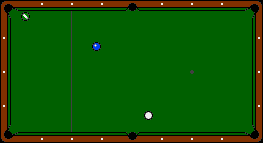
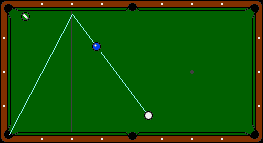
Here's your basic bank shot. Notice that the angle of reflection is less than the angle of incidence. On most pool tables, the harder the ball hits the rail, the more perpendicular is the angle of reflection. The shot in the above diagram was hit with medium hard force. Any softer, and it would have missed wide. This is fairly predictable at steep angles like in the diagram, but it gets pretty non-linear at really shallow angles.
Note that you can change the angle a ball comes off the rail by using english. English just means side-spin. If you hit the ball on its right side, it spins with right english, and if it hits a rail it will come off more to the right than you'd normally expect. Same goes for left english. You can get the ball to do lots of useful things by varying your english. Let's look at an example:

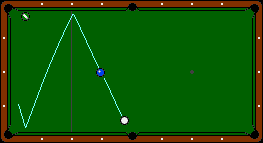
From just looking at the angles, this shot looks dead straight in. But, I guarantee that if you hit it straight, it will miss. When a ball is in contact with a surface, it wants to roll. A ball will constantly change its spin in such a way that it will be more like rolling. So, when it hits the rail with no side spin, the ball is not rolling from the rail's point of view. It's skidding, as if it had right english on it, and so it comes off the rail at a steeper angle than we expected.
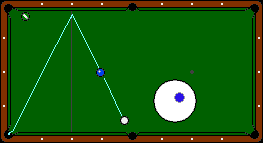
How do we fix it? Well, if the ball wants to roll, let's make it roll! The blue ball will want to be rolling with left english, so we'll have to hit the cue ball with right english. If the ball hits the rail with the same amount of spin as if it were rolling along the rail, then the angle of reflection will be very close to the angle of incidence, and the shot will go. I call this rolling english. You'll have to play with the exact spot to hit the cue ball, depending on the particular table and the particular cue, but the giant cue ball is a pretty good guide. Imagine you're about to shoot, and you're in position, staring at the cue ball. Hit the blue dot. Don't hit it too hard, and remember to follow through, keeping the cue nice and level the whole way.
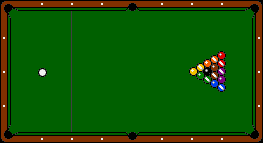

Many people would like to know how to break. There are many different styles, most of them good. The diagram above shows Sean's style. He usually gets a ball in the corner. I prefer to hit the balls straight on with lots of top spin, because it accelerates the cue ball forward after it hits the other balls, and in effect breaks them twice.
You'll find your own style, but here's are a few things to keep in mind:
- Aim for a spot through the cue ball. Imagine you're trying
to put a hole right through the cue ball. - Follow through. Don't snap the cue back after it hits.
- Make sure the cue is level with the floor,
and keep it that way until the cue ball hits the other balls! - Don't move your bridge hand! Don't move your hips, feet,
or even your head, until the balls break.
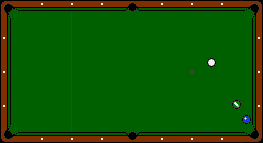
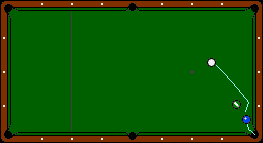
This is a fairly easy shot once you've practiced. Most beginners don't try it, and it comes in handy quite often.
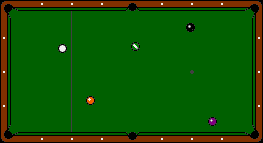
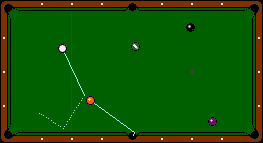
Here's something to keep in mind set-up wise. A general rule of thumb is this: Make the easiest shot first, as long as you can use it to set up your next shot. In other words, when choosing which ball to shoot first, don't just consider the difficulty of one shot. Consider the combined difficulty of at least two shots including set-up.
The above diagram shows an example. While the purple ball may be an easier shot, it would be hard to set up for the orange. Hitting the orange fairly softly almost guarantees a shot on the purple.
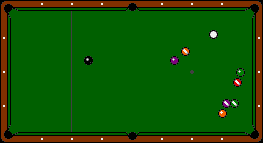
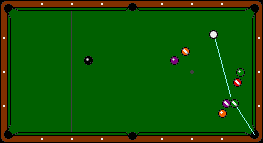
Here's something that most people just completely overlook. Even though the purple striped is kissing the green striped, it is not in the way. Think about an equilateral triangle. You've got a whole 240 degrees of surface on that green ball that you can hit. 180 of those degrees, the ones opposite the purple, will cause the green ball to come off the purple at about 90 degrees to it. That leaves 60 other degrees you can hit without the purple interfering. There's 30 on top, and 30 on the bottom.
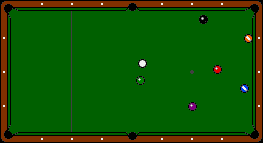
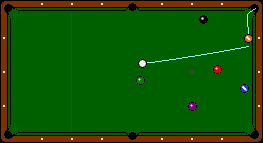
I used to think that left english was a good idea on a shot like this, because it increases the chances that the ball goes in the right direction. However, since hopefully you're not just shooting wildly and counting on chance, just aim the shot like an ordinary cut shot! If your aim is true, you don't need english on a rail shot!
More generally, when shooting rail shots, IGNORE THE RAIL!! Pay no attention to the rail and make no adjustments for it, since a properly hit ball will not be influenced by the rail.
The only exception to this is when the ball is actually touching the rail, but even then it only affects the ball when you're shooting from a very steep angle towards the rail since the cue ball will throw the ball into the rail a little.


Here's a bank shot where the ball is right on the rail. They're harder to make than shots where the ball is not on the rail, unless the angle is not straight in, and then they're a little easier. Make sure the cue ball doesn't get in the way when the ball comes off the rail, so give it plenty of draw. You can do some fun stuff with these shots by using and english, but I'll talk about that later.
